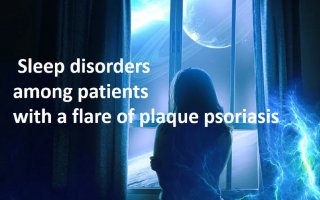Sleep is an essential physiological activity that is dependent on homeostatic sleep drive and circadian rhythm. Sleep and skin are bi-directionally related to each other. Suchskin functions like thermoregulation and control of core body temperature affect sleep course, and the other way around—sleep disorders in patients with skin diseases may influence patients’ life quality and mental health or even exacerbate dermatological symptoms.
Psoriasis is a common, inflammatory, autoimmune skin disease, which is characterized by the presence of erythematous-papular lesions with exfoliation. It can be accompanied by pruritus, burning sensations or pain. Moreover, unaesthetic appearance of skin lesions may cause patients’ mood deterioration, increase stress severity and lead to depressive symptoms. All of these factors lead to an increased risk of insomnia in such patients. There is also a strong association between psoriasis and metabolic syndrome, which may predispose psoriatics to obstructive sleep apnea syndrome (OSAS). Additionally, restless legs syndrome (RLS) is more often observed in patients with different autoimmune or inflammatory disorders – and the same background is discussed in psoriasis pathogenesis. Therefore, psoriatics could be potentially at increased risk for RLS development.
The main aim of the study was to assess the prevalence and risk of sleep disorders development among 60 patients with a flare of plaque psoriasis. Additionally, a control group of 40 age- and sex-matched volunteers without skin diseases was included.Sleep quality was assessed using the Pittsburgh Sleep Quality Index (PSQI), OSAS risk using the STOP BANG (Snoring, Tired, Observed, Pressure, BMI, age>50 years, Neck size, Gender-male), and RLS using the International RLS Study Group criteria and RLS severity scale. Skin lesions were assessed by Psoriasis Activity and Severity Index (PASI). Obtained data were analyzed togetherwith demographic and clinical data.
Sleep disorders are the key comorbidities of psoriasis as they are both mediator and effect. It has been demonstrated that patients with psoriasis have significantly worse sleep quality, more frequently take sleeping medicines and have more severe energy impairment to perform daily activities. Patients with psoriasis have a significantly higher risk of OSAS, which increases with duration of disease, age and BMI. The severity of RLS is significantly higher in patients with psoriasis than in those without skin diseases, which may indicate a negative impact of psoriasis on the course of RLS. PASI should not serve as predictor of sleep disorders in psoriatic patients. The choice of a particular drug in the classical systemic therapy of psoriasis does not appear to influence sleep quality and severity of RLS symptoms significantly. Therefore, it is advisable to include screening for sleep disorders in patients with psoriasis in diagnostic and therapeutic recommendations and clinical practice.
Julia Nowowiejska, Anna Baran, Marta Lewoc, Paulina Grabowska, Tomasz W. Kaminski, Iwona Flisiak
J. Clin. Med. 2021, 10, 664





